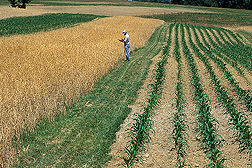 Organic food is often portrayed by its critics as a low-yielding farming method that undercuts the main goal of food production – feeding the world.
Organic food is often portrayed by its critics as a low-yielding farming method that undercuts the main goal of food production – feeding the world.
These critics also argue that if organic farming were to grow much beyond its tiny elitist niche, forests would have to be plowed under because a much greater land mass would be needed to make up for far lower crop yields.
Pretty sad picture isn't it? Organic farming is portrayed as an inferior agricultural method that ends up raping and pillaging the natural world.
The only problem with this argument is that it doesn't square with the facts. (Nor with the actual picture if you check out the organic wheat field pictured above that was part of a USDA trial).
Although many studies have countered these arguments, three recent ones deserve notice.
First, researchers at the University of Michigan recently published a new study in the Journal of Renewable Agriculture and Food Systems that evaluated 293 studies comparing conventional and organic farming.
They found that in the developed world, such as the US, Europe and Japan, organic farming methods yielded slightly less than conventional methods.
But importantly, in the developing world, where food-scarcity is most pronounced, organic methods were actually two- to three-times as productive as conventional agriculture.
Farmers in poorer nations often could not afford the chemicals and fertilizers that are required by high-yielding seed varieties. By farming organically, they could enhance soil fertility by composting waste sources on their farms.
The researchers write that organic farming could produce enough food on a global per capita basis to sustain the current human population, and potentially an even larger population, without increasing the agricultural land base.
"My hope is that we can finally put a nail in the coffin of the idea that you can’t produce enough food through organic agriculture," said Ivette Perfecto, a professor at University of Michigan's School of Natural Resources and Environment, and a principle on the study.
She added that the idea people would go hungry if farming went organic was "ridiculous." (You can listen to a brief interview with the researcher).
Another report out of the Leopold Center for Sustainable Agriculture at the University of Iowa is also significant, for it demonstrates the long-term yield potential of organic methods.
The now nine-year-old trials "convincingly show greater yield, increased profitability, and steadily improved soil quality in organic over conventional rotations," the Leopold Center stated.
The longest running rotation of corn, followed by soybeans, oats with alfalfa, and then another crop of alfalfa, produced 188 bushels per acre of organic corn in 2006. The traditional corn-soybean rotation on conventional fields yielded 177 bushels/acre – a 6 percent deficit from the organic fields.
In soybeans, the organic fields produced 45 bushels per acre in this long rotation, compared with 43 bushels on conventional plots.
Over eight years of data, here's the average corn yield in the various methods:
- Conventional corn, soybeans rotation, 160 bushels per acre of corn
- Organic corn, soybean, oats mixed with alfalfa rotation, 150-1/4 bushels/acre corn
- Organic corn, soybean, oats mixed with alfalfa, alfalfa rotation, 160-1/4 bushels/acre corn
Those include the first three years of the organic transition. If you back those years out, and only look at the organic fields post-transition you get these average yields:
- Conventional corn, soybeans rotation, 173.2 bushels per acre corn
- Organic corn, soybean, oats with alfalfa rotation, 162 bushels/acre corn
- Organic corn, soybean, oats with alfalfa, alfalfa rotation, 176 bushels/acre corn
The study shows that well-managed organic crop rotations, which are key to organic farming practices, actually lead to slightly higher yields than conventional chemical methods and rotations. And in the current ethanol-infused corn boom, farmers are forgoing the traditional corn-soybean rotation and growing continuous corn on corn, which requires a greater amount of chemical fertilizers to keep the yield up.
Finally, organic farming gets criticized for its tillage practices, which critics say leads to soil erosion and leaches nitrates into groundwater. These critics say conventional "no-till" farm methods, associated with genetically modified crops and heavy doses of herbicides, are superior.
But again, the facts point to a different conclusion. USDA researchers report that organic farming methods actually produced healthier soils than no-till conventional methods.
In a nine-year study at the Henry A. Wallace Agricultural Research Center in Beltsville, Maryland, USDA researchers found that the addition of organic matter in manure and cover crops more than offset losses from tillage.
In a final three-year study, corn was grown with no-till practices on all plots to see which ones had the most productive soils. The organic plots had more carbon and nitrogen and yielded 18 percent more corn.
Needless to say, critics won't be convinced by this evidence. But then neither do those who continually assert, in the face of overwhelming evidence, that global warming doesn't exist.
We know better.

